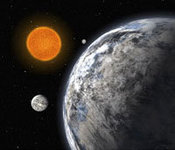Astronomers have discovered habitable planet in constellation Libra
 A decadelong hunt by an astronomer at UC Santa Cruz has yielded the discovery of a planet that could be the most Earth-like planet ever discovered -- and the best case yet for a habitable one, ending our cosmic loneliness.
A decadelong hunt by an astronomer at UC Santa Cruz has yielded the discovery of a planet that could be the most Earth-like planet ever discovered -- and the best case yet for a habitable one, ending our cosmic loneliness.
The planet, called Gliese 581g, is located in prime real estate within the constellation Libra, where it's sweater weather, not too windy, with scenic views of a white sky.
Scientists say there is no evidence that Gliese 581g holds oxygenated landscapes of green and blue that would support microbes, dinosaurs or some alien-looking pre-human. For life, there must be water, and there's no proof of that, according to San Jose Mercury News.
"Our findings offer a very compelling case for a potentially habitable planet," said astronomer Steven Vogt of the University of California Santa Cruz, one of the researchers. "The fact that we were able to detect this planet so quickly and so nearby tells us that planets like this must be really common... there could be tens of billions of these systems in our galaxy."
The planet is believed to orbit closely by the "red dwarf" star Gliese 581. It would be in the middle of the star's "habitable zone"-the range of distances from the star where temperatures allow for liquid water, World Science reports.
Subscribe to Pravda.Ru Telegram channel, Facebook, RSS!





